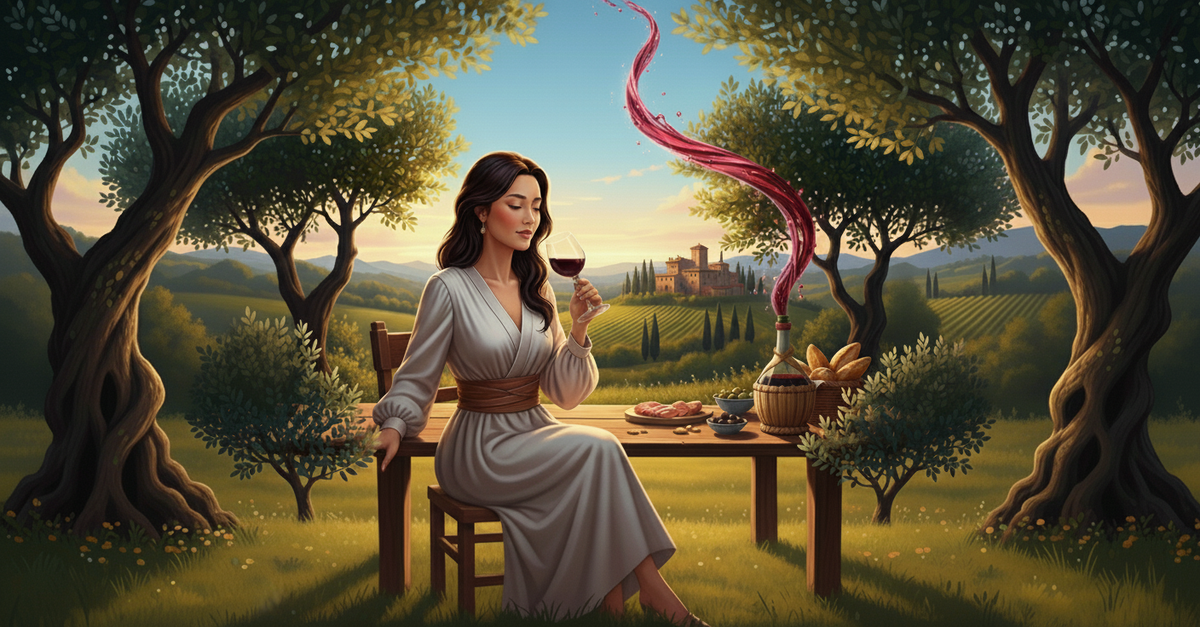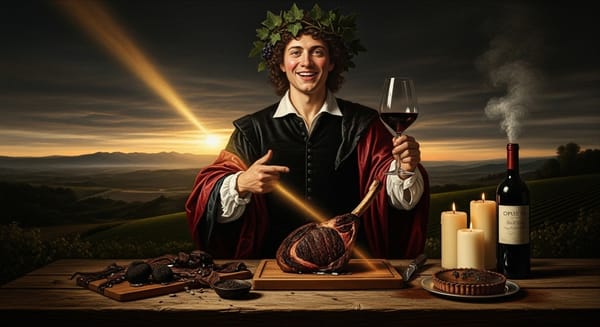Chianti Classico: Melancholy Hills, Exuberant Pulse
Chianti Classico merges centuries of upheaval with galestro‑driven elegance. Discover its history, terroir, sangiovese moods, aging arcs, and why collectors overlook its inner strength while chasing louder trends.

At dawn, the scent of crushed marasca cherry drifts up from a stone fermenter in Castellina, and for a heartbeat the air fractures into two tempos. On one side rides the dull clop of cart wheels that once ferried cask staves along the Via Chiantigiana; on the other, a stainless‑steel pump hums a modern lullaby, pushing cold must toward another controlled ferment. Chianti Classico exists exactly in that dissonant chord. It is a wine drafted by ducal decree in 1716 yet forever revising its own lines; rooted in limestone formed under ancient seas yet sparking with an acidity so vivid it feels freshly minted.
Walk the vines at first light and the land performs its contradictions without apology. Dew beads on galestro shards, each droplet reflecting the blush of an unrisen sun while yesterday’s heat still breathes from the stone. Sangiovese leaves cast silhouettes that resemble ink blots—irregular, suggestive, irrepressibly personal—across a soil that holds the memory of Etruscan furrows and artillery scars alike. Every vineyard row is a palimpsest: hierarchies of tenant and lord, booms of speculative capital, quiet years of neglect, all scratched over and over until the surface bristles with half‑legible stories.
Even the air tastes ambivalent. Aromas of tobacco drying in a neighbor’s barn drift beside the sterile chill of a temperature‑controlled tank room. A cellar hand checks densities with a glass pipette older than his father, while outside a drone buzzes between parcels, mapping vigor. One gesture looks back, the other propels forward, and both feel necessary because Chianti Classico’s identity has always been argued rather than inherited.
To drink the wine is to stand inside that argument. The glass carries the echo of statutes and the rumor of futures, the sting of youth and the grit of age, the sweetness of surviving and the salt of starting over. What you swallow is not a settled narrative but a living tension—between what has already slipped away and what refuses to stay still. That tension is the pulse of the district, and it beats loudest when the morning light first touches the fermenter’s stone lip.
A Border Written in Wine
Cosimo III de’ Medici believed walls could be drawn with ink as surely as with stone when, in 1716, he decreed the zones of "Chianti" and charged wardens to guard authenticity against impostors. But ink smears, economies drift, and by the 1800s Bettino Ricasoli was revising the script, proposing a banister of sangiovese supported sparingly by canaiolo and malvasia. Wars arrived; phylloxera gnawed through roots; tenant farmers fled for city wages. Post‑war industry craved volume, and straw‑bound fiaschi poured oceans of thin ruby liquid across the world—wine that tasted as weary as the countryside that produced it.
Yet decline seeded rebellion. The 1967 DOC sought order; the 1984 DOCG tried sterner discipline, but it was individual estates—Castell’in Villa’s principessa brushing off consultants, Montevertine storming out of the appellation, Fontodi grafting ambition onto a sun‑scorched amphitheater—who shouldered risk. By the 1990s smaller barriques whispered of new oak, critics took notice, and the black‑rooster emblem re‑crossed oceans carrying not nostalgia but renewed intent. Gran Selezione, born in 2014, tightened the standard: estate‑grown fruit, extended aging, no shortcuts. The label reads like a signature at the bottom of a pact—place must come first.
Still, history here is never shelved. In the hamlet of Lamole, terraces rebuilt stone‑by‑stone after wartime shelling now host bush‑vines pruned by grandsons of partisans; in Radda, a shuttered convent shelters amphorae fermenting native yeasts. The past stands shoulder‑to‑shoulder with the present, unwilling to cede the frame.
Hills in Minor Keys
Galestro and Alberese—Stones That Speak
Run a hand across galestro and the marl fractures like pastry crust, leaving blue‑gray dust that smells faintly of pencil shavings and salt. On neighboring slopes alberese flashes white in the sun, slabbed and ringing if you strike it—limestone that once rested under a Miocene sea. Roots navigating these layers taste two dialects of the same language: galestro lends an almost electric lift to fruit, while alberese burrows deeper, knitting tannin to the bone.
Elevation, Exposure, Restlessness
Vineyards perch from 250 to nearly 650 meters. Each altitude offers its own register: lower sites around Panzano soak in afternoon glare, painting sangiovese darker, bloodier; higher reaches of Radda wake to chill and never quite break a sweat, yielding wines that feel cut with mint. The region’s topography resembles a cupped hand catching maritime breath from the Tyrrhenian Sea; evening winds slip inland, combing through canopies and dragging temperature down so quickly you can smell fennel cooling on the air.
Climate change prowls at the margins—budbreak slides earlier, harvests sometimes flirt with August—but altitude and aspect give growers a chessboard of counter‑moves. Some shift plantings uphill; others lean on canopy shade or pick at night. Terroir here is not a postcard backdrop; it is a stage where adaptation plays out in real time.
Villages as Verses
Greve: red earth soft enough to crumble in a fist, yielding wines that glisten with plum and sweet sage. Gaiole: steeper, cooler, where church bells echo off dense forest and the wines smell of rose stem and iron filings. Castellina’s mid‑slopes offer equilibrium—a chord where cherry, thyme, and dust resolve into something almost symmetrical. Each commune expresses Chianti Classico like a stanza in linked poetry: self‑contained yet resonant with the next.
Labor as Philosophy
February pruning cuts are decisions about destiny. Many growers favor cordon speronato now, encouraging balanced vigor, but a few romantics still trellis to arched cane, believing it gentler on sap flow. Cover crops—fava, clover, wild radish—are rolled down in May, forming a straw mat that feeds microbes and denies weeds daylight. Herbicides feel anachronistic; nearly half the region farms organically, several in conversion to biodynamics. Yet there is no manifesto louder than experience: you see it in a grower kneeling to taste soil, in callused thumbs testing shoot length.
Harvest rarely follows spreadsheet logic. Grapes are tasted not measured; seeds should crunch like walnut skin but not rasp; skins must stain teeth yet release pulp cleanly. Pickers move row to row with plastic bins no larger than a child’s backpack—weight spreads evenly, fruit arrives intact. Sorting tables chirp under clusters while dogs nap beneath—an accidental metronome marking the vintage’s heart rate.
Sangiovese’s Unquiet Heart
Sangiovese in Chianti Classico is not one flavor but a spectrum flickering between extremes. In youth it can smell of pomegranate and wet stone; after rain, it turns toward tomato leaf and cinnamon. Its acid cuts like a question half‑asked; its tannin can feel angular as cathedral ribs. Clonal diversity furthers the mood swings: the small‑berried R24 cultivar tightens structure; VCR 23 pushes floral lift; ancient massales near Lamole broaden mid‑palate like sudden sunlight.
The supporting players are fewer now but still evocative. Canaiolo offers a velvet seat for sangiovese’s spine; Colorino darkens color and adds a bitter cherry edge. A renegade strand of cabernet or merlot may thread through some bottlings, but current sentiment leans native, trusting place over passport.
Annata wines, released the spring after harvest, strike with immediacy: sour cherry rushes forward, acidity pricks, tannins chase like percussion. Riserva, two winters older, stretches the note; fruit dims to black raspberry, oak breathes sandalwood, structure elongates. Gran Selezione sits longest, and when it finally speaks the palate feels both dense and feathered—mulberry layered over graphite, acidity coiling rather than stabbing. Each tier is less rung on a ladder than tempo change in a suite.
Between Monument and Murmur
A century ago, many cellars practiced governo: withholding a tranche of late‑harvested grapes, drying them, then pitching the semi‑raisined fruit into spring fermentations to reignite sluggish yeasts. The method lingers on a few farms—as cultural artifact rather than quality essential—but more common now is low‑intervention vigilance. Native yeast fermentations bloom in open‑top concrete and steel; punch‑downs are gentle, more bathing than beating. Large Slavonian botti remain guardians of tradition, yet concrete eggs appear beside them like modern punctuation. Barriques still whisper in certain corners, though often used, rinsed of overt wood chatter.
The aim across styles converges on transparency. Winemakers speak of infusing rather than extracting, of chasing texture rather than concentration. To walk a cellar during malolactic conversion is to smell yogurt warmth mingling with citrus peel—a fragile middle distance where decisions can erase or reveal a vintage’s character.
Portraits in Patience
Castell’in Villa: On a wind‑bitten plateau south of Castelnuovo Berardenga, Princess Coralia Pignatelli della Leonessa farms as though the 1970s never ended. Whole clusters linger in large botti for seasons, not months. When a bottle from the 1993 vintage was opened at a tasting last year, it bled pale garnet and smelled of oregano steeped in dried rose—alive, unhurried, slightly aloof.
Fontodi: The Conca d’Oro amphitheater bakes like a kiln, yet Giovanni Manetti coaxes balance through high‑wire canopy management and judicious shading. His Chianti Classico tastes of dark roses pressed against flint—density without girth, sunlight wrapped in wet stone.
Montevertine: Sergio Manetti’s 1981 exit from the appellation remains folklore. Today his son, Martino, lets sangiovese ferment in open concrete before a gentle courtship with mixed oak. Montevertine’s Le Pergole Torte smells of marasca and tobacco leaf, a wine that laughs at categories even as it deepens them.
Istine: Angela Fronti oversees parcels as high as 620 meters. Fermentations are cool, extractions feather‑light. The resulting bottles pulse cranberry and pink peppercorn—a fresher octave signaling where the region may head as summers warm.
Classification: A Calendar of Intentions
Annata is vernal; it moves quickly across the palate, laughter still in its throat. Riserva arrives like late August, shadows long, fruits beginning to dehydrate on the vine yet still agile. Gran Selezione resembles equinox—balance sharpened, each element present in measured tension. The categories measure time spent in wood and bottle, yes, but they more precisely chart ambition: how far a producer is willing to wait before letting a vintage leave home.
Time’s Refrain
Pour a current‑release Annata and the rim might glow neon ruby; inhale and catch basil stem, red currant, a hint of rain on iron gates. Five years later the same wine returns darker, the rim now garnet; aromas tilt toward dried cherry, pine resin, a faint suggestion of cocoa husk. At fifteen, the fruit sinks yet acidity still thrums, tannins velvet down, and what emerges is tertiary grace: porcini broth, cedar drawer, orange oil. Unlike some noble reds that surrender fully to age, Chianti Classico keeps a pulse of brightness—an after‑glow that flickers on the tongue long after swallowing.
Decanting should be more persuasion than surgery. Young bottlings benefit from a brisk splash; older vintages prefer slow coaxing, perhaps double‑decanted to leave sediment undisturbed. Serve in a Burgundy bowl if possible—the ample curvature lets perfume swirl upward. Temperature matters: sixteen degrees Celsius seems to let acids sing without shrillness.
Pairings are often framed as Tuscan staples—cinta senese pork, ribollita—but consider context: a glass alongside roasted duck draped in five‑spice reveals sangiovese’s cinnamon edge; with aged Manchego the wine’s tomato leaf morphs into sun‑dried oregano.
Betting on Resistance
Fine‑wine markets reward scarcity metrics—production under ten thousand bottles, cult status, critic scores bursting into triple digits. Chianti Classico defies this calculus. Volumes are healthy, hype cycles muted. Yet secondary‑market graphs show a slow, stairstep appreciation for benchmark estates, especially in transcendent vintages such as 2010, 2016, and 2019. The region’s resilience to climate extremes bolsters confidence: multiple elevations, varied aspects, and deep rootstocks distribute risk. Regulatory agility also plays a role; the Consorzio’s tightening of Gran Selezione rules for 2027 signals a willingness to guard top tiers against dilution, a move investors read as brand fortification.
Purchase strategy favors provenance: seek bottles that never left the estate until shipment, avoid mid‑chain brokers who warehouse in temperature drift. Focus on terroir‑driven estates where winemaking choices remain conservative; such profiles age on acidity and phenolic back‑bone, not on volatile oak signatures that fade with trend cycles. Diversify across communes—Radda for lift, Castelnuovo Berardenga for breadth—so a warm vintage in one area balances a cool vintage in another.
But perhaps the greatest return is existential: to back Chianti Classico is to invest in an ongoing conversation about identity, stewardship, and the ethics of pleasure. These wines do not shout; they persist.
Conclusion
One October evening near Monti in Chianti, starlings braided the dusk, their choreography sudden and collective. Below, sangiovese berries waited for dawn picking, skins pliant, seeds crunching between fingers that moments earlier tied loose cane. I raised a glass drawn from a sample tap at the winery; the liquid caught last light and flashed ember‑red—not a flame, but a living coal of memory. Chianti Classico does not ask to be decoded; it asks to be felt, to be met halfway between soil and story. In every swallow lies a cross‑current: heritage pulling one way, impetus another, the drinker floating between. How many histories can reside on a single palate? Only as many as we are willing to hold before releasing them back into the darkening sky.





